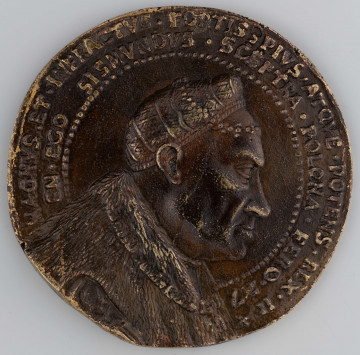
Sigismund I the Old
1840 — 1860
National Museum in Lublin
Part of the collection: Polish medallic art.
Undoubtedly, the most outstanding representative of Renaissance medal-making in Poland was Giovanni Maria Mosca, better known as Padovano. Because of his nickname, it is assumed that he was born in Padua between 1495 and 1499. What is known for sure is that he began his artistic journey in Padua. In 1529, he left Padua. From 1533, he was permanently present in Poland, where he remained for the rest of his life. He probably died in Kraków in 1574 and was most probably brought to our country by Queen Bona, the wife of Sigismund I the Old. Padovano is mainly known as a gifted sculptor, but quite early on he also took up a related field of art, which is medal-making. Dating from 1532, he produced a series of four medals depicting the Polish royal couple, Sigismund I the Old and Bona, and their two children, Sigismund Augustus and Isabella. Contrary to earlier views, it is considered that these works were made outside Poland, and, therefore, before Padovano's arrival in our country. All the medals in the series were created in 1532, as stated in the inscriptions on their obverses, but in the case of Sigismund the Old, incorrect information was added, stating that the King was then sixty-four years old. The same was the case with Queen Bona's medal, except that she was not made younger by a year, but by six years.
The medal depicting Sigismund I the Old is a two-sided work. The obverse features the king's bust in a slightly unnatural pose. The head is portrayed in profile, while the torso is shown more frontally. The inscription on the obverse states that the medal depicts the King of Sarmatia. On the reverse, in the central field, there is an image of a heraldic eagle with the letter S woven into its silhouette. This was a motif that had been appearing in iconography since 1518, and symbolising – as it seems – a close connection of the ruler with his country. In the Renaissance style, the artist also immortalised himself. The inscription says that the medal was made by Jan Maria Patavinus (a native of Padua).
The medal is presented as a 19th-century copy created, like many others, on the wave of interest in Poland's past. It is an interesting example of the cultivation of patriotic traditions in the society living under the partitions. This copy was made after the middle of the 19th century, but it is impossible to establish by who and where it was made.
Leszek Poniewozik
Author / creator
Dimensions
cały obiekt: width: 62 mm
Object type
medal
Technique
silver-coating
Material
bronze
Creation time / dating
Creation / finding place
Owner
The National Museum in Lublin
Identification number
Location / status

1840 — 1860
National Museum in Lublin

National Museum in Lublin

National Museum in Lublin
DISCOVER this TOPIC
National Museum in Szczecin
DISCOVER this PATH
Educational path